Let’s talk wall texture for a minute. There are a lot of different ways to finish drywall and I have researched all of them. For our renovation at the Merc I had my heart set (or so I thought) on perfectly smooth textured walls. (As you know I’m trying to keep the Merc as time-period true as possible.) So in 1928 when it was built, they used plaster walls with minimal texture.
The problem with uncompromisingly smooth drywall texture? A few things.
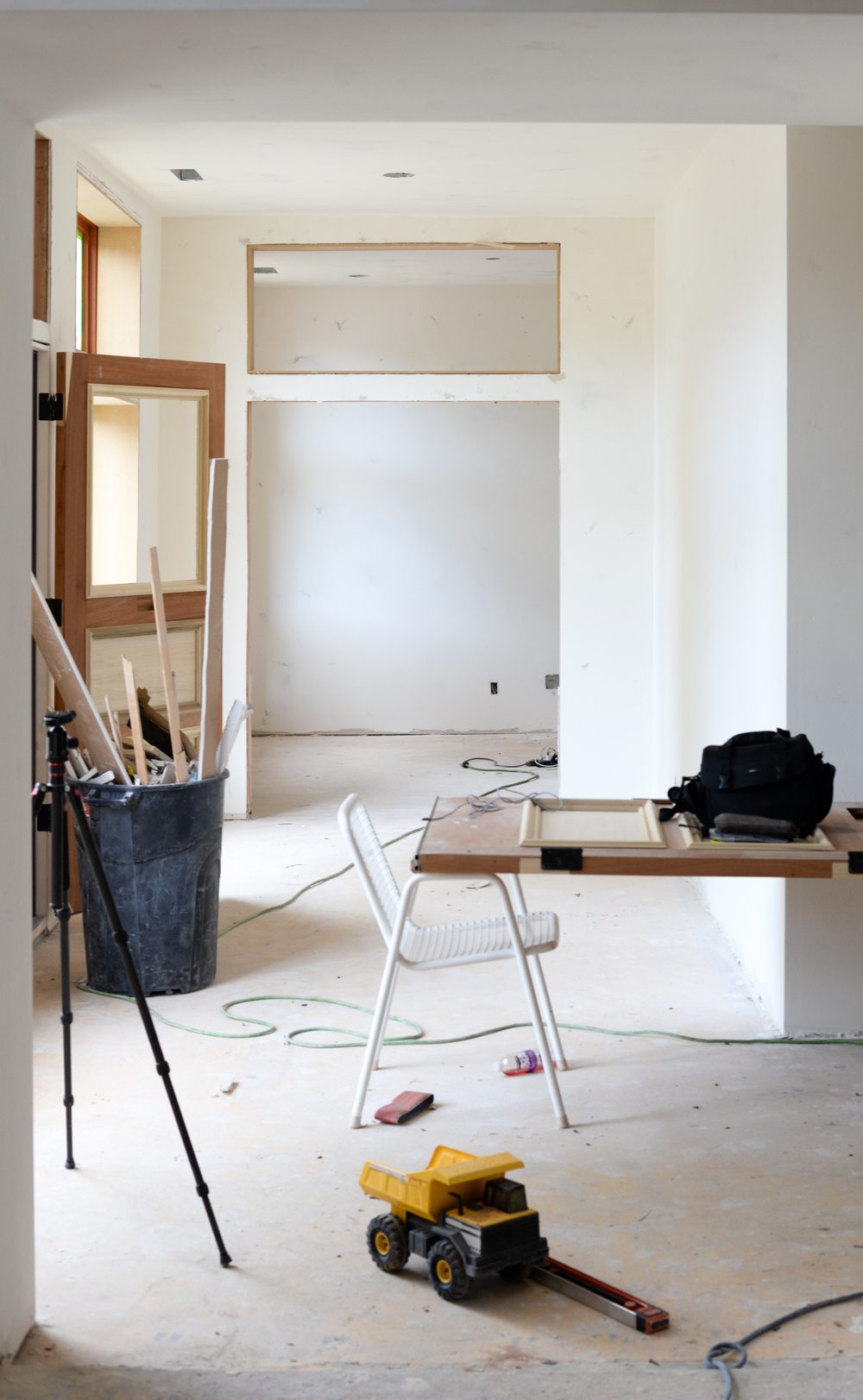
(Real renovation life perfectly captured above)
Smooth Drywall Texture Roadblocks
-
The cost.
Though I didn’t get an actual formal bid for it, my contractor estimated that it would be about 3-5x the regular cost to do a completely smooth finish. WUUUUUUUUT. (I’m wicked jealous of all of you east coasters that get smooth walls standard.)
-
Imperfections Still Show, Just Not as Much.
Go with me on this. Picture your postpartum body in a super tight dress. I know I know, just go with me on this. A smooth texture is like wearing spanx. Yes it helps a lot, you may have smoothed out the texture, but the general shape isn’t going to change all that much. With smooth textured walls, if the walls have any sort of wave or bulge from the framing (which they most likely will cause boards aren’t always straight) that will still be there.
Funzies.
Wall Texture Types
There are a lot of different types of drywall textures, and as I learned in the comments on this blog post, they are very regional. Keep in mind that they can range from very understated to severe, but the general idea for each doesn’t vary.
Here are the most common:
- Orange Peel
- Knockdown
- Smooth
- Swirl
- Old World
In my research I found a great alternative to smooth walls in a texture finish called Old World. that made me a believer that we could have the best of both worlds.
A quick google image search shows a huge range of what Old World texture looks like and thankfully none of them look like mine.
The most important thing is that your drywall finisher clearly understands what you want. Our finisher knew that I wanted the walls almost smooth, so he did a couple of test spots so that I could see what my finish options were. I chose the one with the least amount of variation and they got to work.
We used this texture on the walls and ceiling, you can see in the below picture where the mud is thinner (because it already dried) and how there is definitely texture, but its not everywhere. (The big color variation is because the mud is still wet, when its dry its almost impossible to see in pictures.)
See how there are little spots that the drywall peeks through? That’s where the Old World style kicks in.
When its dry it looks like this:
Trick for a Smoother Appearing Drywall Texture
Another key factor in the visibility of wall texture is the sheen of paint that you are using. The higher the sheen, the sharper the shadows are, which makes the texture more visible. Interesting right?
We are using MY FAVORITE Sherwin-Williams Emerald Matte for all of the walls so the visible texture is significantly minimized. The important thing when using a low sheen paint is to make sure that its high quality, often times the lower the sheen, the less scrubbable, but Emerald is the best of both worlds. Finding the right paint for the job is SO important! Check out my guide here!!
Inquiring minds want to know, what type of drywall texture do you have in your house? And how do you feel about it?
See my full guide to drywall and wall texture here!
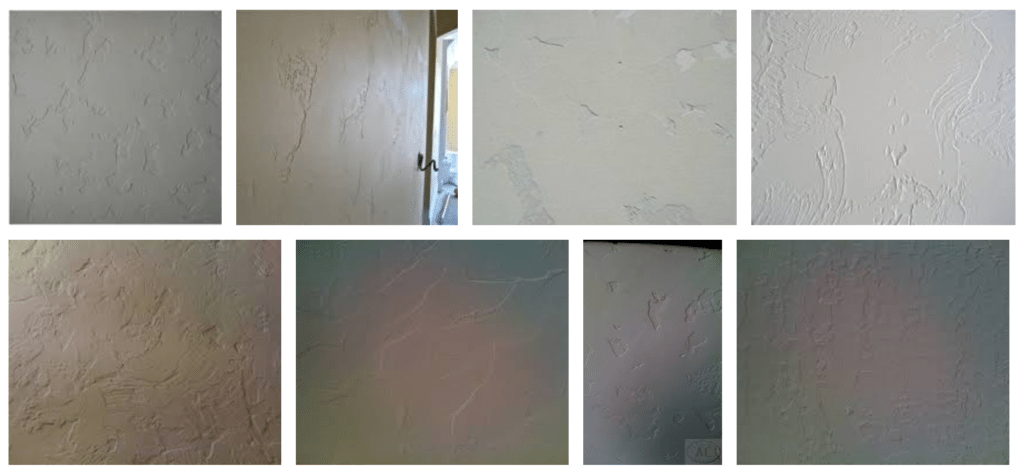
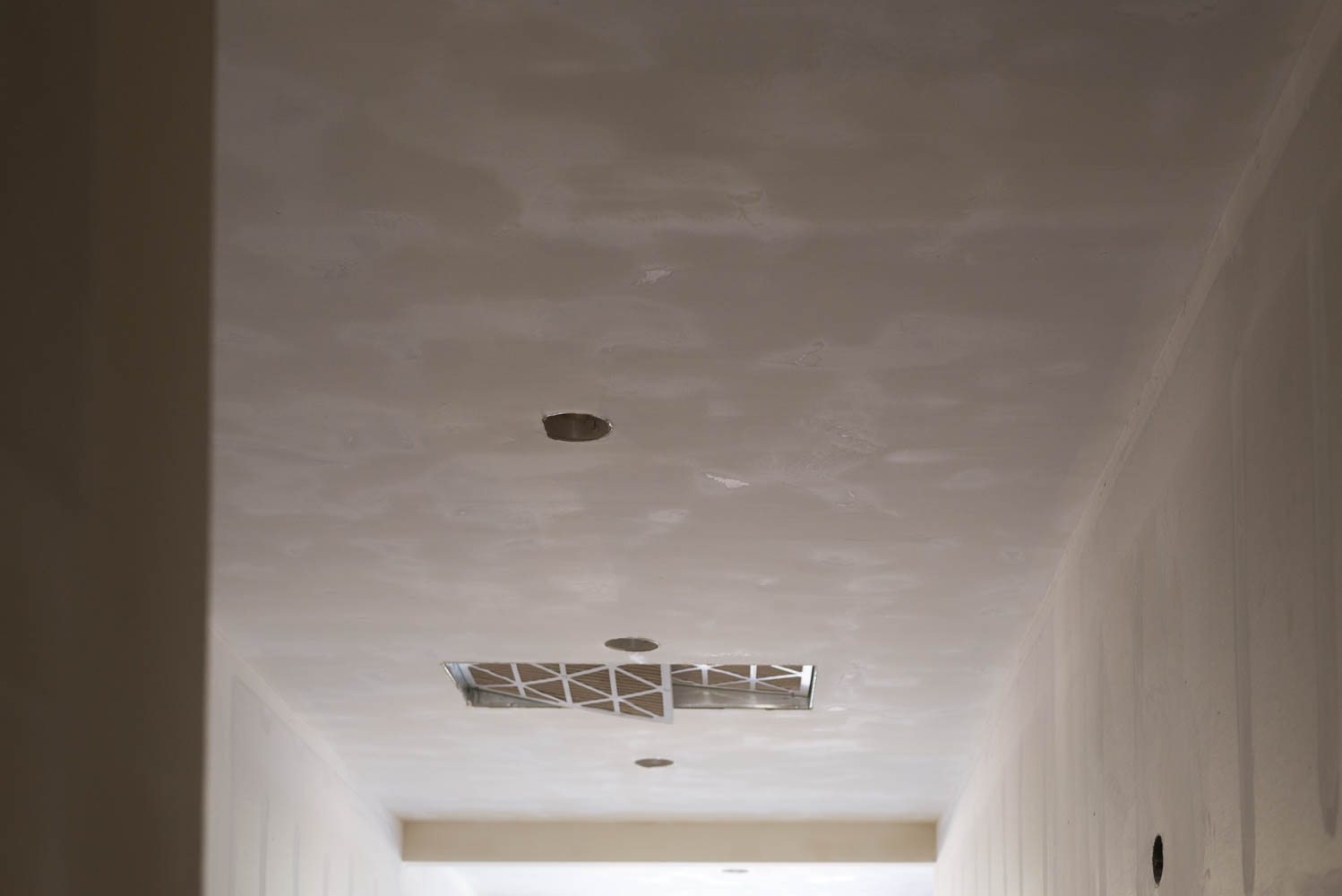
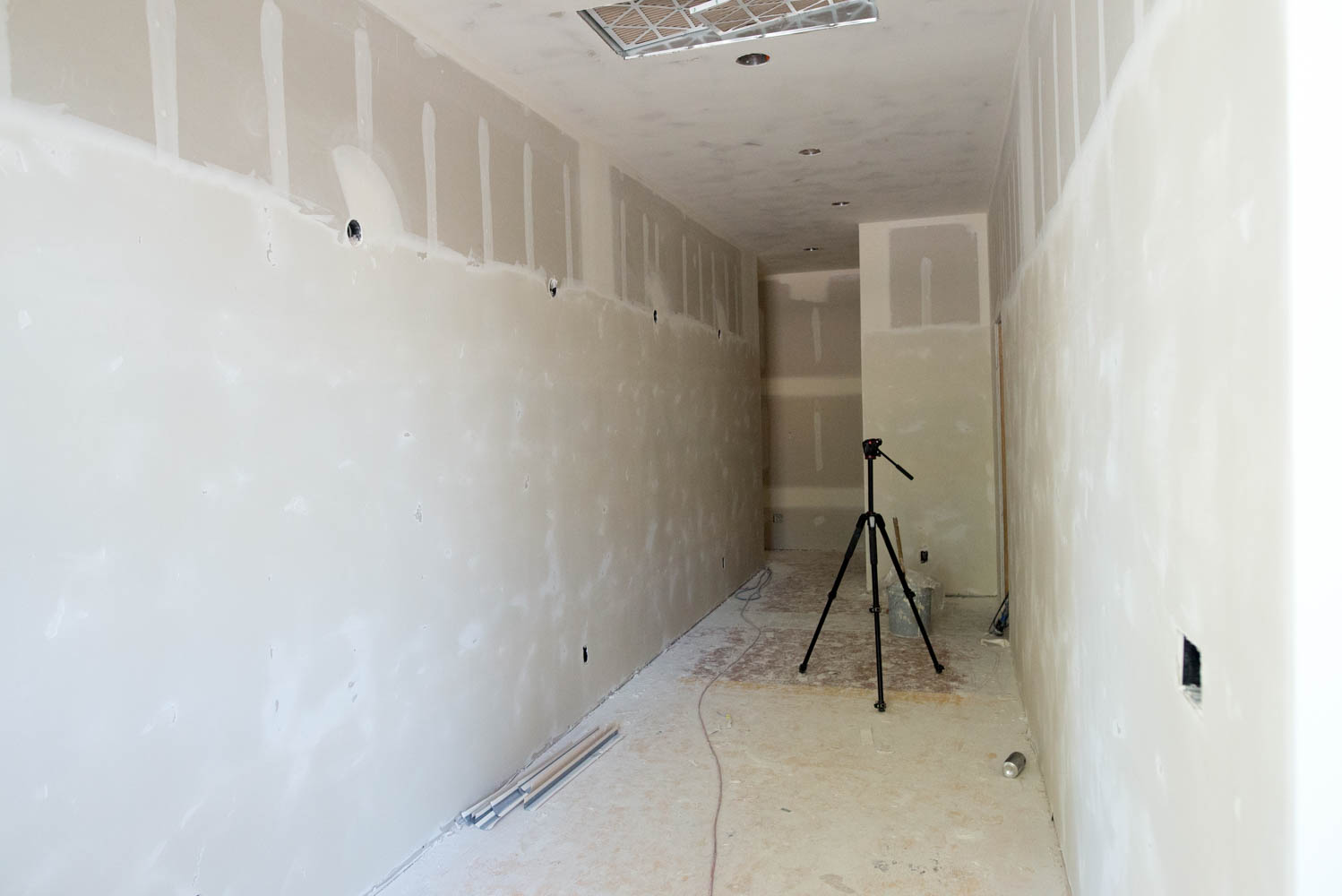
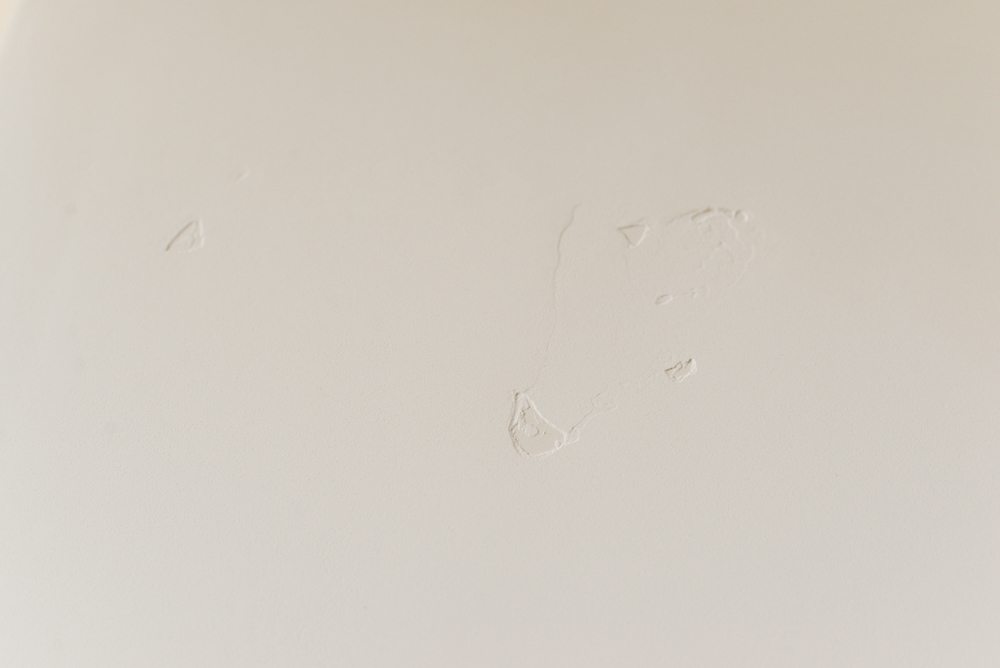
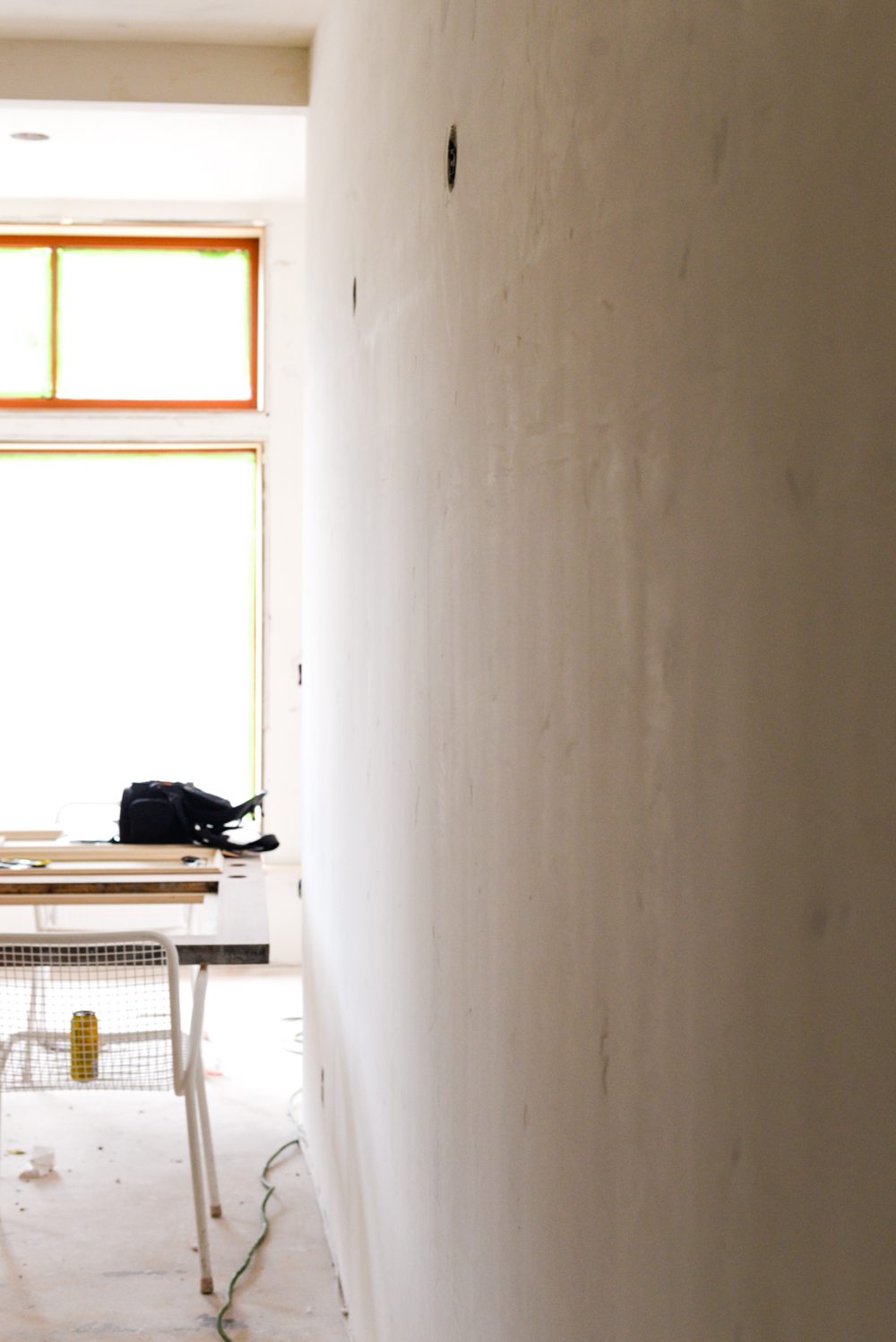
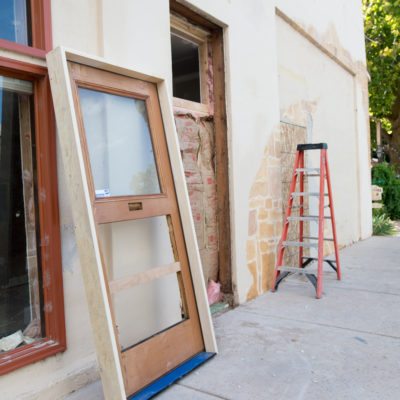
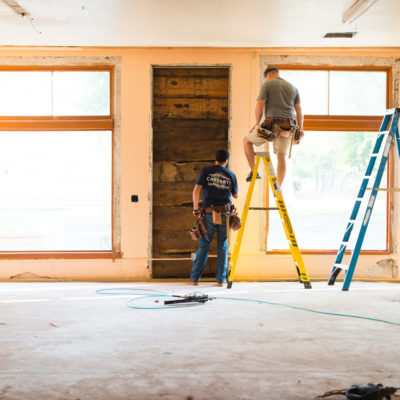
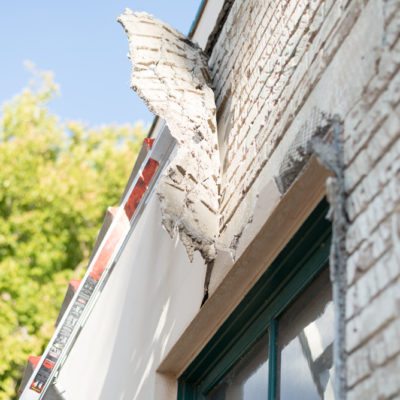
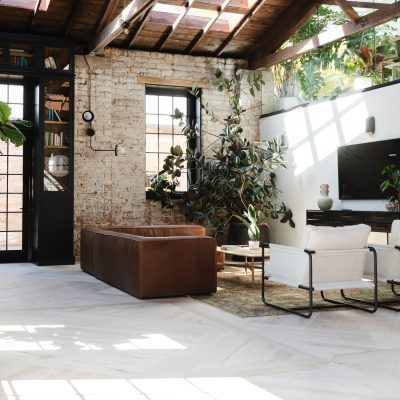
I have mostly smooth old-world texture in my house too & I LOOOVE it!! So so much.
A year late to this thread, but….. I find it interesting that drywall finish varies so much throughout North America. We are building a custom home in Northern California. First off, skilled labor is a thing of the past around here. We have a bunch of companies getting rich off cheap labor. Bosses are back at office bidding jobs and sending out inexperienced workers to get a job done. Cheap labor doesn’t have the knowledge, pride,or desire to do a quality job. Thus, spraying on texture is common practice around here. Less skill, and hides all of the imperfections. 3700 sf- It costs 16k to have drywall hung with knockdown texture. It’s $19k for an “imperfect smooth” (old world kind of look) and $22k for perfect smooth. Smooth walls takes a little longer due to the sanding and it takes a little more expertise. Spraying on texture takes low skill set and hides everything. In conclusion, without talented craftsman, it costs more to accomplish something that should cost less. That’s California in a nutshell.
From wikipedia:
Knockdown texture reduces construction costs because it conceals imperfections in the drywall that normally require higher more expensive stages of sand and prime for drywall installers.
New Englander now in CA. Hate knockdown.
Oh that’s weird to me! It just looks like the plasterer hasn’t practised properly ?
I’m used to completely smooth walls although we have a nasty tendency to textured ceilings in the UK. I much prefer smooth.
I think the texture may work well with the location you’re in and the type of building. I wouldn’t choose that texture, but then I wouldn’t have chosen your building! I think the less textured works better otherwise it might lean more toward a theme restaurant.
We bought an old 1970’s house (that we love!) but it has a different texture on EVERY FREAKING WALL. It drives me CrAzY! I’m curious about the paint. I had a matte paint once and it just scrubbed right off if I tried to wipe it softly. HATED it so I swore to never do that again. My kids are way too messy/dirty/slobs to have a paint I can’t scrub!
What?! This must be an out-west thing? In the midwest all drywalled walls are perfectly smooth…its standard practice to completely coat with mud and sand and definitely not at any extra cost….weird!
Not all of the Midwest. In at least the northern half, almost all walls have light/med orange peel or knockdown in the newest homes. Its a devil trying to match the texture, and God forbid trying to get perfectly taped paint lines! Love flat walls, and most importantly, FLAT ceilings (unpopcorned!)
I am in WI and we have orange peel as well. It was the finish that offered the least amount of texture. I have never actually seen a completely smooth wall. Knock down finish is another popular finish here.
I live in Kansas and I am with you that orange peel is the prominent texture but smooth walls here cost the same. Maybe a couple hundred dollars more but we did it in our house and the cost was not much different at all. Really, I don’t think it was any different!
I live in SE MI and in the 3 houses I have owned, 2 had texture. Only the 100 yr old house had smooth.
I’ve owned a 60’s cape in Maine, a 70’s rancher in Maryland, and a 1910 rowhome in Philadelphia. All have smooth walls… drywall, tape, spackle seams, sand, prime, paint. I’ve never seen covering the entire wall to get a smooth finish.
In my area of Minnesota, only 25% of the new builds are orange peel. Standard bid is smooth, if you ask for orange peel, it might be cheaper. My ceiling is a texture called knock down (flattened out orange peel). I don’t mind it, I would prefer smooth though. The walls in both of my new builds are smooth. Do they not have skilled mudders there? It seems like the same amount of work and a lot more mud! My unpainted walls had feathered out seams (probabaly 11″ wide swath) and a strip over screws. Most of the surface of the wall has no mud. They did the first coat on day one. It dried overnight, sanded the next morning, did coat 2 on whole house. When they were done, they started sanding in area first done (as coat 2 is much thinner than coat 1 and dries quicker). They did touch ups and did a final sanding in morning.
I’m really confused — I’m in Canada and we just fill/sand the seams and prime right over the drywall for a smooth surface, the drywall is never completely coated with mud.
This is what we get up in New England. Honestly – this seems like more work!
Same here in Massachusetts— in all 4 of my houses we’ve always just painted right over the drywall. Weird!
Yes! I’m in Canada (Alberta) as well and I don’t understand why the walls need texture at all. It does appear that they only do one coat of mud over screws/seams and then add this texutre stuff to avoid having to sand anything. I’m not sure it saves much time since these guys have to cover the whole wall with mud to a specific texture. I really don’t get it.
We do this in the midwest where I live! Heck, this is how I did my OWN drywalling–taped the seams, sanded that smooth, then primed the walls with drywall primer. 100% smooth.
Same in Indiana!
I live in western PA, and we do the exact same thing. However, there does seem to be a variety around here. My friend’s house has VERY textured walls in a swirl pattern. (I hate it; she likes it. To each their own.) In older houses around here, only the ceilings have the texture. I’ve also seen the orange peel thing as well as the old world style that Mandi mentioned. It’s funny how there are so many differences. Texturing, of any kind, seems like a lot of extra work to me. I’m quite happy with just mudding screws and seams and then priming.
I grew up in Indiana and smooth was standard. I am building in Montana now and I am getting the same response. 3-5 times the cost for smooth however I am now getting excited about the old world. It gives it some dimension but not too much. Who knew it would vary so much!
Same here in upstate NY, although I grew up in CA and then went to college in AZ, and orange peel walls were ubiquitous in both states. I can’t figure out why it’s such a thing on the west coast. It actually seems like MORE work, not less. We live in a 100+ year old house in NY now, with plaster walls, but when we’ve had small amounts of sheet rocking done in areas that weren’t salvageable, they just tape and mud the seams and sand and then prime over the drywall and it’s all smooth. I don’t get why there has to be a finish. Is it to save the step of sanding?
So the texture thing is shocking to me. I have literally never heard of textured walls being standard. Here (East Coast) they tape just the seams and drywall screws and everything is smooth so when the wall is sanded and ready for paint there is still tons of exposed drywall sort of like in the upper part of your photo. Seams (lol) to me that skim coating the wall for the texture would be more work! We will occasionally have a crack or “popped” screw head which causes a bulge but it isn’t typical. I wonder if it has to do with the amount of settling and shifting. ie. we are not at all prone to earthquakes, etc. here. I literally do not know one person who has textured walls here!
I don’t understand how smooth walls would cost so much more. We tape mud and sand the seams and screws then paint. Beautiful walls at far less labor and cost. Sounds like a (-this is the way we do it) scam.
I wish it was a scam but I have spoke to our local drywall companies in Montana and all have given me the same story. In Indiana, where I grew up smooth is how it was done and it was not more expensive. Who knew!
Here in Minnesota we have smooth walls too – tape the seams, mud the screw holes, sanding as needed, then primer and paint. “Popcorn” textured ceilings were the norm, but I think they are going out of style here. THANK GOODNESS. Textured walls are not standard and add much more expense. Huh. Things are different all over. 🙂
Yes! Another Minnesotan, recently transplanted to NC. We always had smooth walls (unfortunately with popcorn ceilings in our 1960’s house) in our houses/apartments, except our first house which was a 1940’s bungalow and did have a more plastered/textured wall finish. Our recent-build (10yo) house in NC has smooth walls and ceilings.
Interesting! I’m a California transplant living in Maryland–and a contractor at that. Growing up in CA I had a modern home (then built in the 80s!) with textured walls, but all my other homes were older (circa 1900) with smooth texture. I don’t think I’ve seen a textured wall since I moved east a decade ago. I didn’t realize it was a regional thing though! That just blows my mind. I thought the industry just moved away from texture!
Oh my gosh! East coaster here and I had no idea there was anywhere in the US where smooth walls weren’t standard! I’m in the middle of renovations myself and I’m staring at my smooth, unpainted Sheetrock walls like “say what now?” And it was super fast for them to do. I think what you have will look so good though and I can’t believe how huge and incredible it all looks! That place is my dream!
I live in Indiana, and I have never seen a house with textured walls! None of them here have it at all! My house is 97 years old and has plaster walls, but they’re just as smooth as drywall in our addition.
What is the reason for the texturing? Does it save sanding time? I just don’t understand how smooth walls could end up costing more.
Years ago we visited my -then husband’s relatives back east, Massachusetts, and I was so surprised and jealous of the flat, smooth Walls. I grew up in Southern California but I seem to remember the walls in my parents house as being smooth as well. Swiss Coffee, of course. but every house I have lived in has had “orange peel” textured walls, which is absolute pain-in-the-derriere to patch, even a little hole! Aargh! So I’m feeling you’re pain.
I currently have textured walls and I hate them. Love how your walls turned out!
My walls are highly textured and it drives me nuts. It’s always so hard to paint because there are little pockets that the roller can’t reach, so I have to do multiple coats or touch everything up with a paintbrush. It also makes it very difficult to use painters tape because the color bleeds under unless you put on a layer of the adjacent color first (assuming you still have some). I’m super jealous of your smooth walls, enjoy them!
For reference I’m out west in Colorado where this is pretty standard, although more modern houses seem to be moving away from it.
Every home I have ever been to in WA state has textured walls. Never see smooth!
Well, you are dealing with a vintage building and that finish works. While I myself would not have selected that finish, once I had heard the 3-5x more I would have liked it. Yikes! Who would have thought you had to pay extra for what should be standard?!
Had no idea east coast had smooth walls! I have lived in WA and OR and all our walls have been subtly textured on any newer( pre 60s) homes. I recently bought a home built in 1923 in Seattle, and the drywall upstairs had been redone with a slight texture. When we finished the unfinished basement ourselves, I fought my husband and demanded smooth walls, which was extremely hard because we did them ourselves! texture is much more forgiving during the building process and demands less perfection. But i think the smooth walls look so much more elegant, and I am glad i got my way! I will now tell him I am not crazy, I just have east coast sense of style!
Washington resident here, I never ever see smooth walls. Our home is over 100 years old and the only place that hasn’t been textured over the years is our unfinished attic. What I wouldn’t do for smooth walls!
I’m in Oregon and we’re in the middle of a gut renovation (zero plumbing, electrical or drywall remains, and we’ve reframed pretty much everything). The texture thing is a big deal – it’s not only non-standard and super expensive to get a smooth finish, it’s hard to find a contractor who is good at it. In our last house we asked for smooth in a room we redid, and ended up with inadvertent Old World texture…
I FEEL YOUR PAIN! Before we even started this reno process I made sure that smooth texture was a non-negotiable line item on our budget, and I’ve worked hard to hunt down a contractor who’s good at it (drywall is the one thing we aren’t doing ourselves).
I think your choice for the Merc works perfectly!
Katie, What.. wait… you’re not working with the general floor plan of the ranch house you reclaimed from a tenant? Did you decide to gut that house–or buy another?
What on earth? I’m up in Canada as well, and I second the ‘just prime the drywall’. I think this is the first time I’ve ever hear of texturing the walls! Ceilings are a different matter, though.
I’m completely shocked they would charge so much more for smooth walls! They are using so much more product giving you a texture? We’ve drywalled a good portion of our home ourselves, with a smooth finish, and it seems like a texture would be a lot more work. All we do is fill the seams (using a special mudding paddle to fill them) and cover the screw heads. It takes a couple coats with sanding but then you put primer on mostly untouched drywall. I wonder if they figure it takes too much time because the mud needs time to dry completely between coats, making it a few day process. Did they texture in one layer and then were finished? I would think having more mud to crack would be worse in earthquake prone areas.
I’m so glad I’m not the only one confused. Can Mandi (or anyone else 🙂 ) explain why you would put anything over drywall to make it textured and why that would cost significantly less money that having smooth walls? Thanks so much for taking us along for the ride Mandi!!
You guys are blowing my mind with your comments!! From what I’ve gathered from my contractor, finished houses NEVER get just tape and screw patches. So a smooth texture here requires 2 different layers of compound with sanding of both, using special lights that catch the imperfections and tons of man hours!!
It’s standard pretty much across Canada for smooth walls (a few minor exceptions I’m sure). You do need to do two layers on screws/seams and sand between coats/finished coat sand but it’s not as much work as having to cover the walls floor to ceiling with drywall mud. However they would have to come three times, first coat, sand/second coat and then final sand. Even with the 3 days they’re not mudding as much sqft so it should go quickly. I still find it a bit bizarre 🙂
Smooth walls are standard here (NY) and it does take two layers of compound with sanding, but just on the joints and screw holes. Not tons of man hours.
Yeahhhh that’s crazy talk. Here in California we just tape and mud the seams and screws, then prime and paint. So weird.
Northern Utah here – every house I’ve ever lived in (4, to date) has had smooth walls with just tape and screw patches. Maybe it’s a Southern Utah/match the stucco kind of thing?
Canadian here. Our house was built in the 60s and the ‘original’ walls and ceilings (really only the bedrooms) are all textured, somewhere in between popcorn and orange peel. It was painted so many times over the years that it’s not as bumpy as it once was, but it’s a royal pain to match to the point that when we had rewiring done in the guest bedroom I covered the non-matchy texturing over the patched hole with a painting. Everything not original to the house is smooth. I had no idea it was standard in other areas to mud any part of the drywall other than seams and screws!
I never come to comment but this got me all confused too! I’m an NC girl living in Maine. Just did a reno with new drywall. Definitely just mud on the seams with 2-3 mud and sanding passes, primer on the bare drywall. They used a slightly nappier roller for the primer than for the paint.
This is so strange. KY here. All walls are
Smooth. Just do the tape and screws. There are different levels of drywall finish but unless you want a glossy wall you shouldn’t have to cover the entire wall. I despise these textured finishes but I think the one you picked is the least offensive. I see this all over Utah and Colorado and I always thought they were trying to emulate old plaster. I’m really into real lime and gypsum plasters so the fake look just doesn’t appeal to me.
Another East Coaster here to say I’ve never heard of textured walls being standard! It might drive you nuts to hear we had a very good (read: pompous) ‘mudder’ who worked for our contractor. He often boasted how good he was as mudding that he didn’t need to sand which sounded crazy – but he was right! He would come to our house in the evening after the rest of the crew left to mud and flew through the rooms on his stilts and never sanded a thing. Everything is perfectly smooth. We just primed and painted right over it!
I’m just as confused as almost everyone else. I’m in AL and here it’s pretty much all smooth drywall or paneling. Just tape and mud seams and screw holes. Why, oh why would anyone spend time and product covering the entire wall when you can just paint right on it?!
We have discovered that the original owner wallpapered almost every room in the house. The second owner didn’t like it, but rather than strip it off, touch up and repaint, they decided to mud over it, throw on heavy texture, and then paint. So any renovation project we’ve done has been a nightmare because the old wallpaper is now starting to come up! It’s been a pain staking job to remove the wallpaper room by room, but I think we finally have it all.
In Nebraska most of the walls are smooth, you will see some builders do a textured wall but not all. The thing I hate is the ceilings. Its not popcorn so you can wet and scrap it off (which I am sure it is a terrible mess) we have ceilings that they swirl mud around so you some deep grooves, smoother grooves, points, and where the wall and ceiling meet you have a divot that isn’t straight so your not sure where to stop painting and they aren’t painted so you can’t tape the off (you pull off the texture) and when you go to paint they suck it up.
Canadian here too. I didn’t even know textured walls were a thing until I moved to Texas and I have to say, I HATE them. It’s like popcorn ceiling but everywhere. It’s just so ugly and I also don’t understand how smooth walls are more expensive when they are the standard in most other countries/states. What are they doing differently? Some of the walls in our house are crooked and the texture does nothing to hide it, and our house is less than 10 years old, so I don’t buy the argument that texture hides imperfections. If you have that many imperfections that need to be hidden, maybe it’s the quality of the work that’s the issue? Anyways, it’s such a relief when I go to visit my parents and see their smooth walls all over!
Another comment from Canada. The fact contractors are trying to up charge for a smooth finish is crazy talk. We just built a house… perfectly smooth drywall finish. If your drywall installer does a neat job (seams cut neatly, tight fit, etc) its not even HARD for the muders/tapers to give you a smooth finish. Yes it takes two-three coats with sanding in between for the seams, but that seems like sooo much less work to me than having to coat the entire wall evenly with mud. That being said, for your project and the era of your amazing restoration project, I think the old world finish will add a lot of charm and put back some of the history that your building has lost over the years. Love following along with you guys!
I’m an Interior Designer that lives in AZ, but is from Michigan. I can attest to the fact that they just don’t typically do smooth walls out West and if they do it costs significantly more. I have a 1928 house (pretty old for Tucson) and the original part of the house actually has a very textured plaster application that I really like. Unfortunately, it just can’t be matched anymore so when I did an addition I had the drywall guys do a very light hawk and trowel. Being from Michigan, my preference is for smooth walls, but alas I was not willing to spend at least twice (but probably more) to get them.
Here in Vermont we just paint the drywall. Textured walls of any sort would likely deem a house practically un-sellable.
From Canada and agreed that the texture thing on the walls is odd to me. I’ve been in older homes that have it, as I know it was ‘in’ for awhile (along with the popcorn ceilings) and was often used to disguise imperfections as well. I think popcorn ceilings are used mostly because it is a quick spray on texture so that they don’t have to be uncomfortable working over their heads so much. We just had a house built a few years ago and textures/popcorn ceilings were standard but was only a $700 upgrade to get them smooth throughout the house instead and worth every penny. And smooth walls were of course standard.
I feel like drywallers from other areas could totally go into the ‘texture zone’ and do really well offering their smooth walls as standard lol
I’ve just moved to northern Utah from Wisconsin… here I have smooth plaster walls (it’s an older house) but in Wisconsin I had old world texture- I thought wall textures kind of went with trends over time?
I grew up in Washington state and my house had orange peel, I thought it was a 70’s thing but I saw a new house in WA with orange peel and it looked so strange to me!
It’s so interesting to learn that smooth walls are standard on the east coast and Canada.
New Englander here too, and I 2nd (53rd?) the comments about just mudding the seams and screws. My father is a contractor and when I was in middle school my parents embarked on a huge renovation (adding an additional story and new roof onto the house). All us kids got to switch bedrooms but my parents had us help drywall, mud, sand, and paint our individual rooms. Tedious sure, but pretty straight forward. On a practical note, at some point you’ll likely have to cut a hole in a wall to deal with a plumbing or electrical problem. It is much easier to to patch the drywall rather than having to match a texture someone else did.
I’m an architect, and my impression is that contractors of a higher tier will provide a smooth finish as a standard. The ‘knockdown’ and other textures are basically a faster way to achieve a uniform look without the time and skill it takes to properly tape, mud, and sand. It may use more material, but the labor is a lot less. That’s why textured walls are so common in developer-built housing; it’s quicker and cheaper, with less skilled laborers.
You will find texture in older houses that have lath and plaster walls, since that’s a very different process. I think that the look you achieved here is fitting for the age of the building!
I second this. I’m also in Utah but in northern Utah. Spec homes, tract homes and less skilled drywall crews always produce textured walls here. Lightly textured Old World is also very popular in Utah right now which is very convenient for contractors because they can bring in less skilled workers to do the drywall. Highly skilled drywall crews don’t leave you with bowed, bulged or waved drywall so taping/sanding seams/screws then priming and painting for a smooth finish are not an issue. I think the light texture on the walls works for what you are going for in the era and I think it will be more practical for your decorating style because it will be much easier to patch walls when you rotate your designs frequently.
Growing up in CA, all the interior walls were knock down textured. Now my apartment in Iowa has some sort of grainy plaster/brushed stucco thing that I hate! Firstly the texture (amplified by goody paint) just seems too harsh and unwelcoming to me. I could get past that if it was functional but it isn’t! Since it’s an apartment I can’t have holes but I can’t use the 3M strips because the surface is so uneven! Except for the~2 inches by the ceiling where the plasterers were too lazy to coat? Ugh. So looking forward to moving.
*glossy paint
I always assumed texture was used to camo flaws in cheaper builds. Covers flaws. I’ve always thought it was slightly tacky, and splurged on smooth walls in our big remodel here in Texas. Yes, it cost more as they put smooth mud on new drywall and sanded it down. Never knew they could have gone straight to primer on drywall for the same result. Duh. Love those walls, though.
Great discussion. I’m at the point where the builder wants an extra $10,000 to do flat walls. I see that some of you recommend a drywall primer and then to paint. However, I read somewhere about a product you can spray on that looks like a Level 5 flat finish. I thought it was in this discussion, but can’t find it. Any other suggestions besides spending $10,000 (or a suggested “light” Monterrey texture) would be greatly appreciated.
Perth Western Australia here. This is so different to what we have here. Most houses are double brick and brick internal walls. The interior walls have a cement float then are plastered over so the finish is smooth, then cornice to finish the edge between wall and ceilings (all smooth in newer houses , older houses have molded cornice and ceiling roses). I think you call cornice crown molding. Newer houses are built on a cement slab older houses have usually limestone foundations with jarrah flooring. Jarrah is a west Australian hardwood beautiful timber rich dark red-brown which is also used for high-end furniture. Eastern states building codes are not the same as here , they are usually brick veneer and timber or Steele frame interior.
Wow, the most discussion ever on wall texture. Here in Ca we just call it imperfect smooth. Is there something I am missing?
Hey hey. What is the paint/mud you are using? In desperate need of some advice
Sheet Rock +3 light weight compound. It east to sand, however application technique is the key for a successful finish and smooth wall…
I move to San Antonio, TX from Chicago. Smooth walls at every home I live in Chicago. Now, In Texas all the home have textured walls.(Orange Peel) The worse part is that you can see every spot were walls has been repaired/patched due to lack of matching the Texture.
Currently, I am smoothing my walls. The reason houses get texture walls is because its hard to find drywall finishers that can finish drywall without seeing drywall seems. Specially ceilings and worse in rooms that get sunlight through the windows.
I spent 20 years repairing walls and resurfacing walls after removing wall paper, making them smooth for painting.
In Texas, textured walls are the rule for low and medium-priced homes and are used in many higher-priced ones as well. The issue is not just a lack of skill of the drywall finishers. Textures can help hide imperfections in the wall studs, ceiling joists, and drywall. Warped studs and joists are common here. A warped stud can require mudding a wall for several feet on either side, to hide the bowing. The workers doing the texturing have to make up for whatever is lacking in materials or craftsmanship of everyone coming before them. I’ve used three drywall guys for our houses, and all of them have the skill to hide seams and cover nail heads (they use three coats with sanding between) and to produce smooth walls, if the walls are straight to begin with. But I imagine that 90% of their work in new construction involves texturing to help hide wavy walls and ceilings. Apparently it’s faster and cheaper for a builder to do things this way. Having lived with textured walls for all of my life, they don’t bother me, but seeing a wall or ceiling that isn’t perfectly straight would drive me crazy.
I see this thread is a few years old. I’m a Canadian contractor and home builder and have very rarely seen or installed textured wall finishes… It’s just not done. It’s only occasionally used in high traffic commercial areas. It is a harder wearing surface (the texture compound dries harder than joint fill compound). It’s also actually a lot more expensive to do. And here is the reasoning for it : even though texture hides imperfections, you still have to do 1st coat tape+mud and a 2nd coat to fill and feather. This is for all joints and fasteners. These coats can be done on the same day without drying period in between (despite what a lot of contractors will tell you). Up to this point the, the process is the same for both Textured and smooth finished walls. Moving on, for smooth finish, a 3rd “finishing” coat is skimmed and feathered out 12″-14″ over all joints and a thin skim on fasteners. This is left to dry and a quick sanding is done the next day. For texture, the texture compound is sprayed on the whole surface of the wall ((this is A LOT of material… the 1st major cost contributor) and then the material is “knocked down” or troweled to achieve the texture. This is a very messy process that included a lot of extra prep material, prep time, and clean up (2nd major cost contributor). The next step for both smooth or textured walls is they need to be sealed/primed using drywall sealer + primer. This is a 1 coat process and is generally sprayed on. Textured walls will require a heavier coat using up to 1/3rd more paint (which is an expensive product – 3rd cost contributor) to achieve complete coverage. This also applies to the 2 x color coats to finish. Smooth walls are just cut in and rolled. Textured wall take twice as long to cut in and then will require 1st color coat to be sprayed for proper coverage (lots of prep to protect all other surfaces from over spray) and 2nd colour coat completed using a deep napp roller sleeve. In the long run, the texture costs more in material and labour due to the difficulty in finishing the final product, which counters the marginal time savings achieved from the actual texture install. Completely makes no sense to me why anyone would consider this to be a cheaper alternative. The only time texture is cost saving is when it’s used on ceilings as a smooth finish ceiling does take a lot more time, material, effort, and expertise to acquire the full level 5 finish (the whole surface is coated, not just the seams and fasteners). But the extra cost on the ceilings is only about an 1/4 more expensive than texturing and an extra day or 2 in scheduling which can be easy recouped elsewhere in the build/reno process (I usually schedule this over a weekend when most other contractors don’t work, which means I don’t actual lose any time.)
Nice one, there is actually some great facts on this post some of my subscribers may find this useful, will send them a link, many thanks.